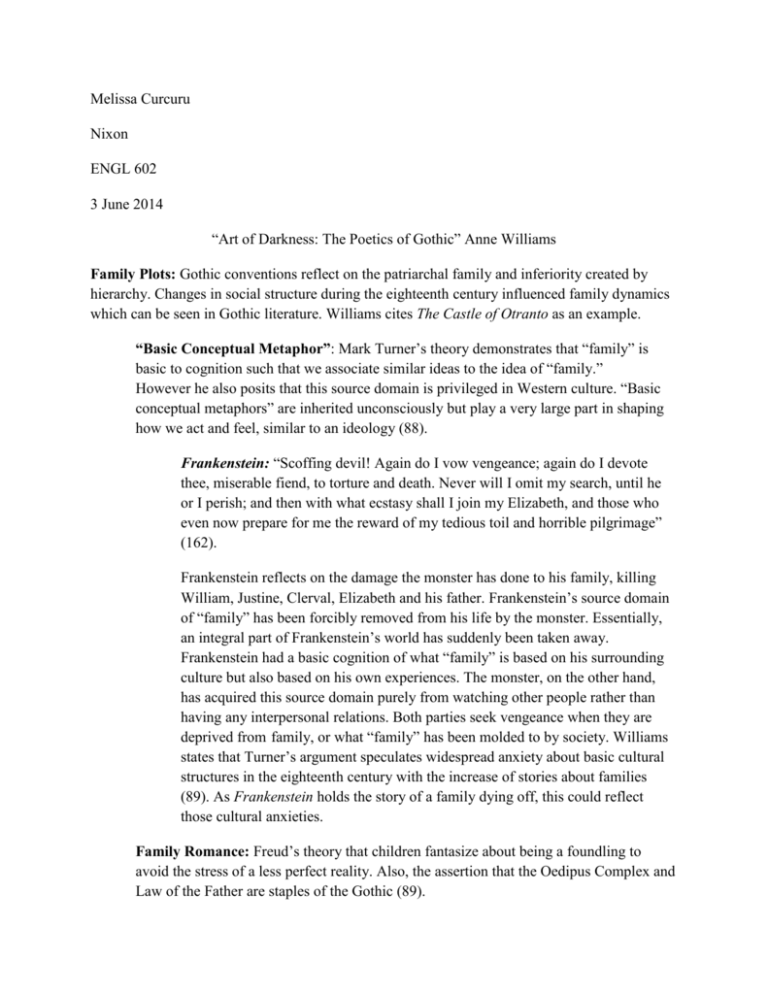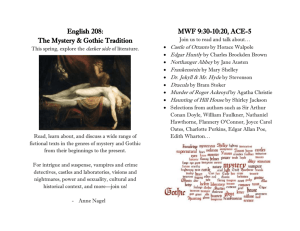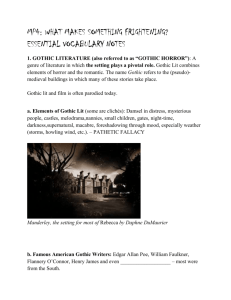
Melissa Curcuru
Nixon
ENGL 602
3 June 2014
“Art of Darkness: The Poetics of Gothic” Anne Williams
Family Plots: Gothic conventions reflect on the patriarchal family and inferiority created by
hierarchy. Changes in social structure during the eighteenth century influenced family dynamics
which can be seen in Gothic literature. Williams cites The Castle of Otranto as an example.
“Basic Conceptual Metaphor”: Mark Turner’s theory demonstrates that “family” is
basic to cognition such that we associate similar ideas to the idea of “family.”
However he also posits that this source domain is privileged in Western culture. “Basic
conceptual metaphors” are inherited unconsciously but play a very large part in shaping
how we act and feel, similar to an ideology (88).
Frankenstein: “Scoffing devil! Again do I vow vengeance; again do I devote
thee, miserable fiend, to torture and death. Never will I omit my search, until he
or I perish; and then with what ecstasy shall I join my Elizabeth, and those who
even now prepare for me the reward of my tedious toil and horrible pilgrimage”
(162).
Frankenstein reflects on the damage the monster has done to his family, killing
William, Justine, Clerval, Elizabeth and his father. Frankenstein’s source domain
of “family” has been forcibly removed from his life by the monster. Essentially,
an integral part of Frankenstein’s world has suddenly been taken away.
Frankenstein had a basic cognition of what “family” is based on his surrounding
culture but also based on his own experiences. The monster, on the other hand,
has acquired this source domain purely from watching other people rather than
having any interpersonal relations. Both parties seek vengeance when they are
deprived from family, or what “family” has been molded to by society. Williams
states that Turner’s argument speculates widespread anxiety about basic cultural
structures in the eighteenth century with the increase of stories about families
(89). As Frankenstein holds the story of a family dying off, this could reflect
those cultural anxieties.
Family Romance: Freud’s theory that children fantasize about being a foundling to
avoid the stress of a less perfect reality. Also, the assertion that the Oedipus Complex and
Law of the Father are staples of the Gothic (89).
Sexual Discourse: Foucault’s binary between the good of men and evil of women also
symbolizing the transition from neoclassism to Romanticism. Men represent “the
deployment of alliance” while women are “the deployment of sexuality.” Also, repressed
sexuality and the unconscious as discoveries of the Gothic are addressed (91).
Nightmere’s Milk, The Male and Female Formulas: The “other” gendered “female” became
newly visible in eighteenth century literature. Since 1976, feminist critics have argued that
gender is crucial in Gothic, with a mass-market paperback revival in the 1960s. The Male Gothic
echoes primitive anxieties about “the female,” specifically the mother as women are inseparable
from their role as sexual being, either as object or subject. Williams cites King’s Carrie and
Levin’s Rosemary’s Baby.
The Female Gothic: 1. Generates suspense through limitations imposed by the chosen
point of view; we share the heroines’ mistaken perceptions and her ignorance. 2. Explains
away the supernatural. 3. Demands a happy ending such as the conventional marriage
plot of Western comedy and the heroine experiences a rebirth. 4. Organized around
resources of terror and imagined threat, sometimes explained by the heroine’s
imagination (102-5).
The Male Gothic: Derives its most powerful effects from dramatic irony created by
multiple points of view. 2. Posits the supernatural as a “reality.” 3. Has a tragic plot
where the protagonist experiences a failure or death. 4. Specializes in horror,
revulsion, and blood (102-5).
The Male Gothic, Si(g)ns of the Fathers: Lacan’s mirror stage and Freud’s theory of the “I”
provide indicators of the power of gaze. In the Gothic, the male gaze is used to deem the female
as the inferior and signify power relations. The Male Gothic used gaze to objectify women and
make her submit to his will. William’s cites Spenser’s The Faerie Queene and Lewis’s The Monk
as examples.








